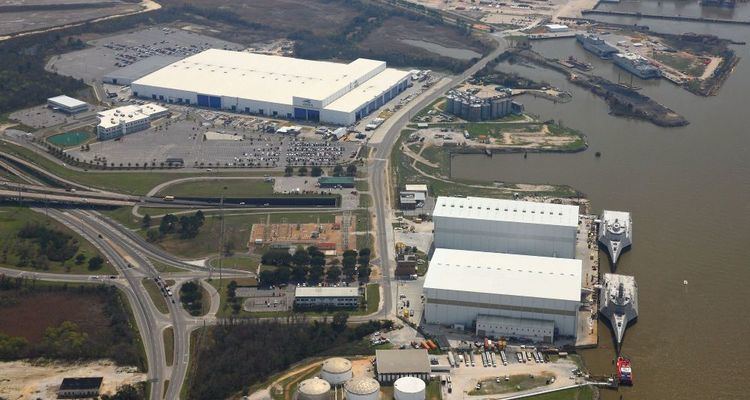Type Subsidiary Website usa.austal.com Founded 1999 | Industry Shipbuilding Number of employees 4,000 | |
 | ||
Products Aluminium commercial anddefense vessels CEO Andrew Bellamy (24 Feb 2011–) Profiles | ||
A day in the life of an austal usa employe
Austal USA is the American branch of operations for Australian shipbuilder Austal. The facility, based on Blakeley Island in Mobile, Alabama employed more than 3,100 workers in early 2012, and has since grown to a little over 4,000 employees and contractors as of 2016. Due to expanded shipbuilding contracts from the United States Navy, the company announced in March 2012 that it planned to invest an additional $160 million in upgrades to its facilities and to increase its workforce to roughly 4,000 employees in the next few years.
Contents
- A day in the life of an austal usa employe
- Austal usa building a joint high speed vessel
- Projects
- Unionizing efforts
- Discrimination allegations
- References
Austal usa building a joint high speed vessel
Projects
The company built the Lake Express for service across Lake Michigan, and the Alakai for Hawaii Superferry. Huakai, the second high-speed vehicle-passenger catamaran for Hawaii Superferry has been launched at Austal USA. At 113 meters (371 feet) long, the new vessel is 6 meters (20 feet) longer than the Alakai, thanks to a bi-fold ramp, added by Austal to its stern, for use in austere ports without shore-side loading facilities, making it suitable for military use. The National Geographic Channel series MegaStructures featured an episode in September 2007 that detailed the construction, launch, and sea trials of the Alakai, the first catamaran Hawaii Superferry.
Austal USA is also currently constructing the Independence class of littoral combat ships for the United States Navy, based on a 127 m (417 ft) advanced trimaran seaframe, with one completed and a second under construction as of 2010. In March 2015, Navy Secretary Ray Mabus testified before Congress that the Navy intends to purchase a total of 52 the vessels. The final 20 will be upgraded with new capabilities. The cost of each ship is about $350 million.
It was announced on November 13, 2008 that Austal USA had won a U. S. Navy contract to build ten high-speed transport ships, known as the Spearhead class Joint High Speed Vessel. The design, with a catamaran seaframe, is drawn from the Austal-built MV Westpac Express. Unlike the Littoral Combat Ship, the Joint High Speed Vessel will be for transport, not combat.
The bankruptcy of Hawaii Superferry, and the construction problems on their first Littoral Combat Ship reduced Austal's profit margin to only $9.2 million on revenue of $500 million in 2009.
On July 22, 2010, Austal USA hosted a keel-laying ceremony at its shipyard in Mobile, Alabama to signify the erection of the first modules on USAV Spearhead (JHSV 1), lead ship in the 10-ship Joint High Speed Vessel (JHSV) program, The JHSV program has a potential worth of over $1.6 billion for the company. On December 10, 2012, the navy awarded its final option under its current contract, and ordered JHSV-10.
On March 31, 2015 Austal USA signed a contract with US Navy worth $ 691 million for two Independence-class ships. Shipyard builds for the Independence class is in Mobile, Alabama. Under this contract company plans to request three LCSs per year through 2025.
Austal USA also signed a contact for 10 Joint High Speed Vessels (JHSVs). One of them, the Trenton (JHSV 5) completed acceptance trials March 13 and will shortly be delivered to the Navy's Military Sealift Command.
On May, 2016 Austal USA has been awarded a $18.5 million contract from the Navy for the 12th Expeditionary Fast Transport (EPF) vessel.
Unionizing efforts
Following complaints from the Sheet Metal Workers' International Association (SMWIA), Austal USA has twice been found to have engaged in unfair labor practices with respect to the organizing effort of unions by the National Labor Relations Board. Unionization had been rejected by employees in elections held in May 2002 and April 2008. A third attempt in August 2011 was again rejected with a vote of 613 against unionization to 367 for it. The SMWIA filed a new complaint with the labor board after the result.
Discrimination allegations
In March 2008, the company was sued by 22 employees for alleged racial discrimination and a hostile work environment. The company was found not guilty in separate discrimination trials that culminated in October 2011 and January 2012. A request for a new discrimination trial was rejected in March 2012 by a federal court. After appeals, seven of the plaintiffs were allowed to proceed to trial. Juries found in favor of Austal USA in April, 2015
